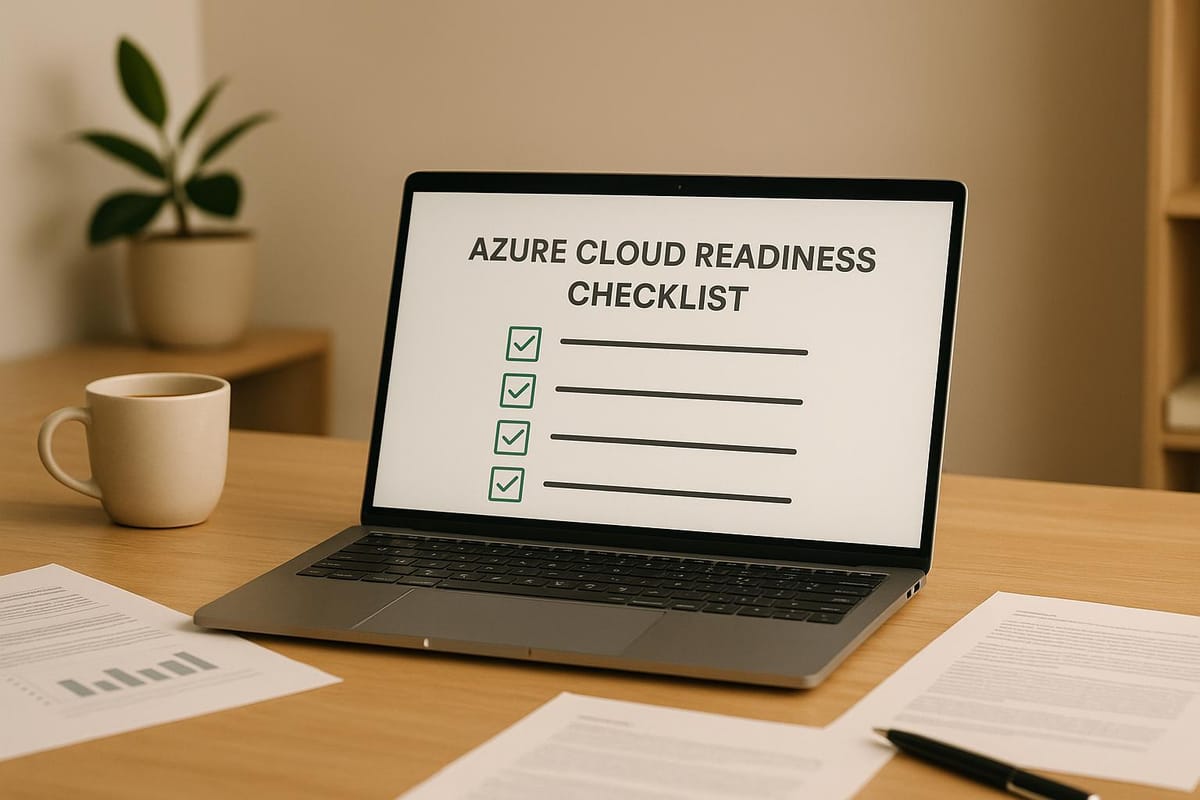Azure Cloud Readiness Checklist
Ensure a successful Azure migration with our comprehensive checklist covering IT assessment, security compliance, cost planning, and strategy.

Migrating to Azure can transform your business operations, reduce costs, and improve security. But without proper planning, it can lead to mistakes, compliance issues, and unexpected costs. This checklist breaks down everything you need to ensure a smooth transition, from assessing your current IT setup to managing costs and ensuring security compliance.
Key Steps:
- Assess your IT assets and dependencies: Use tools like Azure Migrate to inventory systems and identify interdependencies.
- Review security and compliance: Ensure data protection aligns with UK regulations like GDPR and ISO 27001.
- Plan your budget: Leverage Azure pricing tools to estimate costs and identify savings opportunities.
- Choose your migration strategy: Options include rehosting, replatforming, refactoring, or replacing applications.
- Prepare post-migration: Test systems, set up monitoring, and establish backup protocols.
Why it matters:
With over 95% of Fortune 500 companies using Azure, SMBs need to plan carefully to stay competitive in the digital economy. This checklist simplifies migration into actionable steps. Ready to start? Dive in to learn how to make your Azure migration a success.
Assess cloud readiness using Microsoft Assessments
Current Infrastructure Assessment
Before moving to Azure, it's crucial to take a detailed look at your current IT setup. This means creating a thorough inventory of your systems, understanding how they connect, and identifying any changes needed. For instance, when Microsoft transitioned 3,500 internal applications to Azure, they retired or reworked around 30% of them. This kind of groundwork forms the backbone of your migration strategy, ensuring every step - whether it's security measures or cost evaluations - is based on accurate and current data.
IT Assets and Dependencies Review
Start by listing all your IT assets - this includes servers, applications, databases, and storage systems across both on-premises and cloud platforms.
Azure Migrate is a key tool for this process. It’s a free service that uses a lightweight appliance to perform agentless discovery of on-premises environments, such as VMware and Hyper-V virtual machines, as well as other virtualised and physical servers. It gathers detailed metadata, including server configurations, disk and network information, installed applications, roles, features, and performance stats. If needed, you can also document assets manually.
After identifying your assets, map out their interdependencies, especially for critical applications and services. This step helps you categorise relationships by their importance and potential impact. At the same time, collect key business details, such as ownership, data sensitivity, compliance requirements, and criticality.
Look for "quick wins" - workloads that are relatively easy to migrate but deliver significant value. These should be prioritised based on their importance to the business and readiness for the cloud. Begin with lower-risk workloads like development, testing, and non-critical systems before tackling production environments.
Legacy Systems and Upgrade Requirements
Older systems can pose unique challenges during migration. Hardware or software might need updates to meet Azure's compatibility standards. Azure Migrate can help flag outdated systems that may require upgrades or replacements. Address these issues early to avoid delays in your migration timeline.
Operating system compatibility is especially important. Older operating systems may require manual tweaks to ensure they boot and connect properly in Azure. Microsoft's "Verify required changes before migrating" documentation provides detailed guidance for both Windows and Linux systems.
The Azure Migrate appliance itself has specific requirements, such as needing Windows Server 2016 or newer. Its onboarding script won’t run on older versions, so make sure your assessment environment is up to date before starting.
When planning the migration of individual applications, decide whether to rehost (lift-and-shift), refactor, rearchitect, rebuild, or replace them. Legacy applications often benefit from refactoring or replacing rather than a simple lift-and-shift approach. Also, review your network connectivity needs, as the Azure Migrate appliance requires an active internet connection and access to specific URLs. Adjust your network settings as needed to support both the assessment process and the migration itself.
With a solid understanding of your current setup, you can move on to evaluating security and compliance requirements.
Security and Compliance Check
It's time to take a closer look at your security framework and ensure compliance with UK standards. This step is critical for laying the groundwork for a thorough cost analysis and planning your migration effectively.
Data Security and Access Controls Assessment
Start by evaluating your data environment. Categorise sensitive information and create a comprehensive inventory of data types - such as customer records or financial data - to identify where it's currently stored. Pay extra attention to safeguarding sensitive data, applying stricter security measures to critical datasets.
Use encryption to protect data both in transit and at rest during the migration process. Azure offers encryption tools, and you should enforce TLS 1.2 or higher for all client connections.
Access control needs to be airtight. Regularly review permissions and use Azure role-based access control (Azure RBAC) to limit who can access specific data and resources. Multi-factor authentication (MFA) is a must for all Azure Active Directory-based accounts. Additionally, make Azure Active Directory your central hub for authentication and authorisation, and routinely audit user access to ensure it aligns with your policies.
Monitoring is another vital aspect. Use Azure Monitor alongside the Activity Log to set up alerts for any changes to critical resources. Tags can help you identify and track Azure resources that process or store sensitive information.
If you're conducting test migrations, implement data masking and anonymisation to protect sensitive information. To further secure your environment, consider using separate subscriptions and management groups to isolate different security domains.
UK Regulations Compliance
Data protection measures are just one piece of the puzzle. A solid security framework is essential for navigating the regulatory landscape during an Azure migration. Compliance with GDPR is particularly important for organisations handling customer data or personally identifiable information (PII) in the cloud. Remember, while cloud providers like Azure offer robust security features, it's your responsibility to ensure these measures meet GDPR standards.
The challenge is real - 57% of UK IT decision-makers view GDPR as beneficial for consumers but challenging for organisations, and 50% cite "recording of processing activities" as a significant hurdle.
To stay compliant, establish Data Processing Agreements (DPAs) with your cloud provider. These agreements should clearly define responsibilities and cover areas such as data breaches, processing, confidentiality, and security. Ensure your provider can manage data subject rights, including access, correction, erasure, and portability. For data transfers outside the European Economic Area (EEA), ensure compliance with GDPR through mechanisms like standard contractual clauses or adequacy decisions.
Azure offers tools like Azure Policy and Azure Blueprint to help you manage data location. Use Azure Policy to enforce security rules across your resources, ensuring data remains encrypted and stored in approved regions.
Here’s a quick look at some key compliance frameworks and their requirements:
| Compliance Framework | Key Requirements | Cloud Impact |
|---|---|---|
| UK-GDPR & Data Protection Act 2018 | Transparent data processing and safeguarding rights | Secure and lawful handling of data using appropriate technologies |
| NIS Regulations 2018 | Security measures and incident reporting | Strong monitoring and threat detection systems |
| Cyber Essentials | Baseline cyber protection | Focus on endpoint and network security |
| PCI-DSS | Cardholder data protection standards | Enhanced payment security with encryption |
| ISO/IEC 27001 | Framework for ISMS | Comprehensive security governance |
Compliance isn't just about technology - your team plays a crucial role. Train staff to recognise personal data and understand what constitutes a data breach. Establish clear policies for handling data subject requests, such as access, erasure, or corrections, and document any non-compliance issues to show awareness and manage risks effectively.
Before migration, review and update your website's privacy policies. Include essential details like the identity of the data controller, processing purposes, legal basis, legitimate interests, data recipients, withdrawal rights, and retention periods. These updates ensure you remain compliant throughout the transition.
Finally, conduct regular security audits to keep your data protection measures sharp and effective. With a strong security and compliance framework in place, you'll be ready to tackle the financial planning phase of your Azure migration.
Cost Analysis and Budget Planning
Once security and compliance are sorted, it's time to dive into the numbers. A well-planned budget is your best defence against surprise expenses and ensures you can make informed choices as you move to Azure.
Using Azure Pricing Tools
Azure provides several free tools to help you estimate migration costs in pounds sterling. The Azure Pricing Calculator is a great starting point for estimating monthly expenses. It allows you to specify the services you need, adjust configurations to match your requirements, and view cost estimates for different Azure regions. It also accounts for cost-saving options like Azure reservations, savings plans for compute, and the Azure Hybrid Benefit.
For a more comprehensive view, the Total Cost of Ownership (TCO) Calculator compares your current on-premises costs with Azure estimates. Another helpful tool is Azure Migrate, which collects detailed metadata about your current workloads. It analyses your infrastructure and provides recommendations for right-sizing your resources in Azure.
Keep in mind that Azure pricing is listed in US dollars, but local estimates use recent London spot rates for accuracy.
Here’s a breakdown of typical cost categories to consider during migration:
| Cost Category | What's Included | Typical Duration | Pricing Notes |
|---|---|---|---|
| Assessment Tools | Azure Migrate, third-party ISV tools | Ongoing | Azure Migrate is free; ISV tools may incur charges |
| Migration Services | Azure Database Migration Service Standard | One-time | Free for offline migrations |
| Migration Services Premium | Azure Database Migration Service Premium (4-vCore) | One-time | Free for the first 6 months, then £0.29/hour |
| Server Replication | Azure Migrate server migration | Per machine | Free for the first 180 days, then £19.50/month |
| Storage & Transfer | Azure Storage, transactions, data transfer | During migration | Charges apply even during free periods |
Reducing Azure Costs
Azure migration can lower your total cost of ownership by as much as 40% if you focus on cost efficiency. One key area is right-sizing your resources. Many organisations initially over-provision, but tools like Azure Migrate and Azure Advisor can help you adjust virtual machine configurations to better align with actual usage.
Beyond right-sizing, there are other ways to save. Azure Savings Plans for Compute can reduce compute costs by up to 65% when you commit to a fixed hourly spend. For workloads with consistent demand, Reserved Instances offer discounts of up to 72% with one- or three-year commitments. Additionally, the Azure Hybrid Benefit allows you to bring existing Windows Server or SQL Server licences to Azure, potentially saving up to 85% compared to standard pay-as-you-go rates.
Other strategies include enabling autoscaling and disabling idle resources to cut unnecessary expenses. Setting up Azure Budgets and Alerts can help you stay on top of your spending.
When it comes to storage, choosing the right tier can make a big difference. Use the Hot tier for frequently accessed data, the Cool tier for data accessed less often, and the Archive tier for long-term storage. You might also consider Azure Spot VMs, which utilise unused capacity at reduced rates. Be aware, though, that they can be interrupted if demand increases.
For more detailed advice, check out the Azure Optimization Tips, Costs & Best Practices blog, which offers practical insights tailored to SMBs scaling on Microsoft Azure.
Finally, tagging your Azure resources is a smart move for managing costs. Tags can indicate ownership, purpose, or project association, making it easier to track spending across your organisation.
Some businesses have even managed to cut Azure logging costs by up to 90% compared to standard Azure Monitor pricing. For instance, by adopting solutions that charge around £0.16 per GB for log ingestion.
With a clear understanding of costs and optimisation strategies, you'll be well-prepared to plan your migration efficiently. Next, it's time to define your migration goals and strategy.
Migration Planning and Strategy
Once you've completed your IT, security, and cost assessments, the next step is to create a detailed migration plan. This will help ensure a smooth transition to Azure while keeping business disruptions to a minimum.
Migration Goals Definition
Setting clear goals is essential for a successful migration to Azure. Before moving workloads, take the time to understand why you're making the switch and what you hope to achieve. Your migration goals should align with your overall business needs and deliver measurable results. These goals will shape your migration strategy and ensure it supports your broader business objectives.
Start by pinpointing areas where you expect to cut costs, such as retiring outdated infrastructure. Then, evaluate how Azure's scalability can meet both your current and future workload demands. Establish specific metrics for success, and factor in seasonal trends or growth plans to ensure your strategy is comprehensive.
Security should also be a priority. Define which security improvements - like network security groups, advanced threat protection, or enhanced encryption - you want to implement in Azure.
Think about the Azure services that best suit your business needs. For instance, Azure AI can provide customer insights, Machine Learning can enable predictive analytics, Azure IoT supports connected devices, and Azure DevOps can streamline development processes.
It’s also vital to understand the business drivers behind your move to the cloud. These could include exiting data centres, mergers and acquisitions, reducing costs, addressing end-of-support technologies, meeting regulatory requirements, ensuring data sovereignty, or achieving greater scalability.
Finally, focus on quick wins by identifying servers and databases that can be migrated with minimal effort. This can help demonstrate early success and build momentum for the broader migration.
Migration Approach Selection
The right migration strategy will depend on your specific business goals, whether you're aiming to reduce costs, improve scalability, or enhance performance. A well-planned Azure migration can deliver significant value to your organisation.
One popular framework is the "6 Rs" strategy, which categorises applications and helps you select the most suitable migration path. Below is a summary of the common approaches:
| Migration Strategy | Best For | Key Benefits | Potential Drawbacks |
|---|---|---|---|
| Rehost (Lift-and-Shift) | Stable workloads needing quick migration | Quick to implement, minimal disruption, immediate results | May not address existing technical issues |
| Replatform | Applications that can benefit from platform-as-a-service (PaaS) features with minor tweaks | Lower maintenance, improved reliability | Requires some technical adjustments |
| Refactor | Applications needing code optimisation or technical debt reduction | Better performance, lower maintenance costs | Time-consuming, requires development expertise |
| Rearchitect | Applications requiring major scalability improvements | Supports cloud-native features and future innovation | High time and resource investment |
| Replace | Non-core functions that can be shifted to SaaS solutions | Simplifies operations, reduces development workload | Limited customisation options |
| Retire | Redundant or low-value systems | Cuts costs, streamlines IT landscape | Needs careful impact evaluation |
Real-world examples highlight how these strategies can be applied. For instance, General Electric used the 6 Rs framework across 9,000 applications - rehosting about 50% for speed while retiring 20% to eliminate inefficiencies. Liberty Mutual refactored key customer-facing applications to leverage cloud-native features for improved performance, and Intuit replaced non-core functions with SaaS solutions to free up internal resources.
For organisations that can't afford downtime, a phased migration approach can be particularly effective. One company successfully migrated 80% of its mission-critical workloads in carefully planned stages, ensuring that customer-facing services remained uninterrupted. Similarly, another organisation moved 1,800 applications in waves over several years, maintaining stability throughout the process.
Partnering with an experienced IT provider can also help simplify the migration process and reduce risks.
Post-Migration Preparation
After a successful migration to Azure and completing your initial assessments, the work isn’t over. Ensuring long-term performance and security requires post-migration preparation. Just because your workloads are now running in the cloud doesn’t mean the process is complete. The next step is all about thorough testing and setting up monitoring systems to keep everything running smoothly. Skipping this phase could lead to complications down the line.
Testing and Validation Procedures
Post-migration testing is your safety net to confirm the accuracy of your data and the performance of your systems. Without it, you might only notice issues weeks or even months later - when they’re far more challenging to resolve.
Start by creating test environments that mirror your production setup. These environments should replicate the same network settings, security configurations, and resource allocations as your live systems. This helps ensure that applications and services perform as expected in the Azure environment.
For data validation, use scripts and processes to check the integrity of your transferred data. Compare it to the source to ensure there are no discrepancies, which is especially critical for databases and file systems. Even minor inconsistencies can cause major problems later.
Run performance tests to catch potential issues like query regressions, parameter sensitivity, or missing indexes. These problems might not show up immediately but can surface during regular operations, so it’s better to address them early.
Make sure your testing covers all critical data, applications, and services. Develop detailed test scripts that focus on your most essential business processes. To get a fuller picture, run these tests at different times to simulate varying loads and usage patterns.
Once testing confirms everything is working as expected, shift your attention to continuous monitoring and backup strategies.
Monitoring and Backup Setup
After validating your migration, monitoring and backups become the backbone of maintaining Azure’s performance and security. Tools like Azure Monitor provide a comprehensive view of your environment.
"You can't optimise what you don't observe. Monitoring is your cloud's early warning system." - Umesh Pandit
Enable monitoring across all web apps and services, including key infrastructure components like virtual machines, containers, storage, and networks. Group related resources into resource groups to make oversight more manageable.
Set up actionable alerts for predictable failure scenarios. Use SMS, emails, push notifications, or even voice calls to ensure your team is notified promptly. Azure offers free activity log alerts, service health alerts, and resource health alerts.
For example, in October 2024, Kuldeep Singh encountered issues setting up alerts for failed Azure Database Migration Service tasks. VarunKumar Tripathi outlined a solution using Azure Monitor and Log Analytics. By enabling diagnostic settings, creating a Log Analytics workspace, and configuring alerts with a Kusto query, they were able to detect failed migration tasks effectively.
Streamline reporting by creating role-based dashboards and workbooks. These tools allow team members to access relevant information without being overwhelmed by unnecessary data. Consider integrating monitoring into your deployment quality checks, whether pre- or post-deployment.
When it comes to backup and disaster recovery, Azure Backup offers a reliable, cost-effective solution that doesn’t require additional infrastructure. To ensure your backup strategy is solid, document requirements like workload type, backup granularity, compliance needs, recovery objectives, data residency constraints, and retention periods.
"A backup only matters if you can count on it to restore when it's needed." - Veeam
Schedule backups during off-peak hours and double-check storage replication settings. Azure also provides a 14-day retention period for backup data in a soft delete state, which comes at no extra cost.
To enhance security, implement Azure role-based access control for fine-grained access management and use Azure Private Endpoint for secure connections through Azure Private Link.
Finally, keep optimising your setup by monitoring KPIs and user behaviour metrics. Regular cost analysis using Azure Cost Management and Billing can help you track spending and identify trends, ensuring your Azure environment remains efficient and cost-effective.
For more detailed advice on post-migration strategies, including cost management and performance tuning, check out Azure Optimization Tips, Costs & Best Practices. It’s a valuable resource for SMBs looking to scale effectively on Microsoft Azure.
Summary and Next Steps
After reviewing the detailed assessments above, it's time to solidify your Azure migration strategy. With a clear plan in hand, your journey to the cloud becomes more manageable. The checklist provided serves as a practical roadmap for SMBs, helping you gauge your readiness and sidestep common pitfalls during the transition.
Checklist Steps Summary
The Azure Cloud Readiness Checklist focuses on five crucial areas to guide your migration:
- Infrastructure assessment: Take stock of your current IT assets and their interdependencies.
- Security and compliance evaluation: Ensure your data protection measures align with Azure's standards and UK regulations.
- Cost analysis and budget planning: Use Azure's pricing tools to avoid unexpected expenses.
- Migration planning and strategy: Define clear objectives and choose the best approach tailored to your business needs.
- Post-migration preparation: Establish monitoring systems, backup protocols, and validation steps to ensure long-term success.
With these steps outlined, you're ready to dive into the planning phase.
Getting Started with Migration
Start by conducting a thorough assessment of your IT infrastructure, applications, and workloads. This step lays the foundation for all your migration decisions and helps you map out the landscape.
Securing your connection to the cloud is critical. A secure Edge Gateway offers robust protection during migration. As Brandon Nowak, IMS' Systems Architect, emphasises:
"A big piece is before anything gets done, to have a secure connection to the cloud, not just doing it through web browsers."
Evaluate your team's expertise in Azure to identify any skill gaps. For training, Nowak suggests leveraging Microsoft Learn:
"Generalised training would be really anything off of the Microsoft Learn page. It's pretty comprehensive."
If needed, consider working with a Managed Service Provider (MSP). An MSP can help mitigate risks, ensure compliance, and manage your cloud environment. Nowak notes:
"The big thing with the MSP is going to be generally their ability to work with you, and if they're certified to actually work within that cloud structure."
Real-world examples highlight the benefits of Azure Migrate. Healthcare organisations like Metro South Health in Brisbane and Englewood Health in the US used it to assess workloads, plan migrations, and achieve cost savings with improved performance. Similarly, Eltes, a Japanese risk management firm, transitioned to Azure without downtime while modernising its platforms.
Kick things off with a pilot project to fine-tune your migration process. This approach allows you to test and optimise your strategy before moving on to larger, mission-critical systems.
For more guidance on Azure cost management, security, and performance, explore Azure Optimisation Tips, Costs & Best Practices (https://azure.criticalcloud.ai).
FAQs
What challenges do businesses often encounter when migrating to Azure, and how can they address them?
When moving to Azure, businesses often encounter hurdles like compatibility challenges, security and compliance concerns, unexpected expenses, and potential downtime. If not handled properly, these issues can disrupt daily operations.
Here’s how to tackle these challenges effectively:
- Thorough planning: Evaluate your current infrastructure to spot compatibility issues and ensure your systems meet Azure's requirements.
- Focus on security and compliance: Protect sensitive data by implementing strong access controls and encryption methods.
- Manage costs smartly: Keep an eye on expenses and take advantage of Azure's cost management tools to stay within budget.
- Strategic scheduling: Reduce downtime by scheduling migrations during off-peak hours or periods of low traffic.
By addressing these areas, businesses can make their transition to Azure smoother while keeping risks to a minimum.
How can small and medium-sized businesses comply with UK regulations like GDPR when migrating to Azure?
Ensuring GDPR Compliance During an Azure Migration
When migrating to Azure, small and medium-sized businesses must prioritise compliance with UK regulations like GDPR. Thankfully, Azure offers built-in tools to make this process smoother. These include options for data residency, privacy controls, and automated data protection features, all designed to align with GDPR standards. This ensures your data is managed securely and handled with transparency.
To further strengthen compliance efforts, businesses should implement clear data governance policies. Regular compliance audits are essential, as is a robust process for managing data subject requests efficiently. By using Azure's privacy and security tools, organisations can protect sensitive information and maintain compliance throughout the migration and beyond.
What are the best ways to manage and reduce costs when migrating to Azure?
Managing Costs During and After Your Azure Migration
Keeping expenses in check during and after your Azure migration starts with leveraging Azure Cost Management and Billing. These tools give you a clear view of your spending and help you stay on top of your budget.
One smart move is to rightsize your virtual machines - adjust their capacity to match your actual workload requirements. Another effective strategy is to schedule automatic shutdowns for non-production environments, cutting down on unnecessary costs when resources aren’t actively being used.
For workloads that are predictable, explore options like Azure savings plans or reserved instances. These can bring down costs significantly by offering discounts on long-term commitments. Regularly reviewing your expenses, reallocating resources efficiently, and eliminating unused or underutilised assets can also make a big difference. Tools such as Azure Advisor can guide you with tailored recommendations to spot inefficiencies and enhance cost management.
With these strategies in place, small and medium-sized businesses can stretch their Azure budget further while ensuring they get the most out of their investment.




